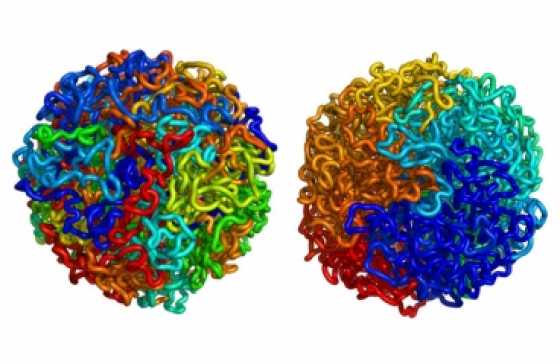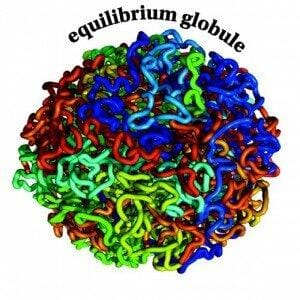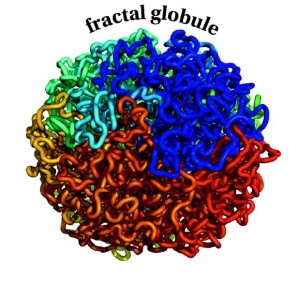Fractal Globule Model of Chromatin Packing Reinforced

Scientists from Lomonosov Moscow State University have strengthened the fractal globule model of chromatin packing. In their Physical Review Letters paper, the researchers present a theory and a computer simulation supporting the existence of a unique metastable fractal globule, a repetitive, ordered, non-entangled state where dynamics are faster and the nuclear machinery can act more easily.
Our genetic material is tightly packed in the nucleus of the eukaryotic cell. DNA wraps around histones, forming loops called nucleosomes. These nucleosomes are stacked to form fibers called chromatin, which can engage in a higher packing level to form chromosomes. DNA packing and unpacking needs to be an efficient and fast process, as it occurs in every cell division and DNA replication events. There is still debate in the field about what kind of global packing state exists in the nucleus. Some scientists support the equilibrium globule, an entangled state similar to the ones that happen when the cables of a phone charger, TV or any other device are lumped together. But it makes sense to think that the massive amount of information stored in the genome should be organized in a way that is easy to access any part of a chromosome in a predictable way. That is why other theorists support the fractal globule model, where DNA is made of non-entangled, stacked and neatly ordered loops. As the name suggests, it would be a fractal structure, one made of loops of different sizes repeated in the small and large scale. A fractal globule packing allows the cell machinery to work faster due to faster thermal diffusion. Without entanglements, it is more dynamic, allowing long range interactions and faster, better gene transcription regulation. Moreover, recent studies indicate that the chromosomes in the cell nucleus may be packed into a fractal globule.
Fractal globule model supported by the longest polymer chain thermodynamics computer simulation
“According to the existing theories if the polymer chain is folded into a regular equilibrium globule, the mean square of the chain link thermal displacement increases with time as time to the power 0.25”, — says Mikhail Tamm, a senior researcher at the Department of Polymer and Crystal at the Physics Faculty of the Lomonosov Moscow State University. Tamm and colleagues had a similar theory for a fractal globule chain link, but posterior computer simulations of the thermodynamics of the longest polymer chain so far (250000 units) yielded a higher number: 0.4. This means that the movement of each polymer unit in a fractal globule would be faster than their theory predicts, and faster than in a regular globule. This results are in agreement with available experimental data and reinforce the fractal globule theory of chromatin packing.
Source: BiologyNews


